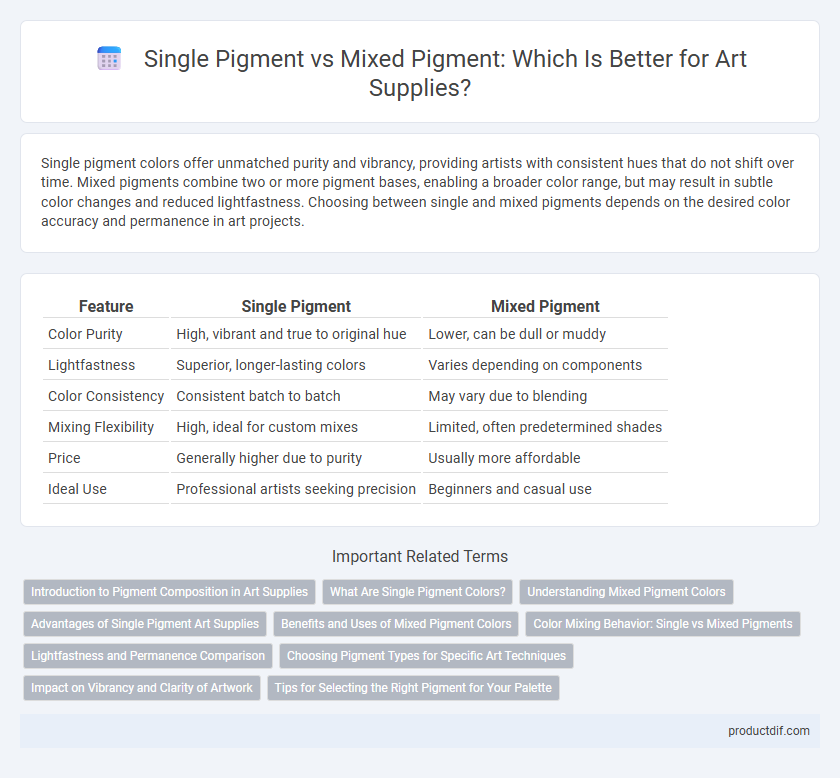Single pigment colors offer unmatched purity and vibrancy, providing artists with consistent hues that do not shift over time. Mixed pigments combine two or more pigment bases, enabling a broader color range, but may result in subtle color changes and reduced lightfastness. Choosing between single and mixed pigments depends on the desired color accuracy and permanence in art projects.
Table of Comparison
| Feature | Single Pigment | Mixed Pigment |
|---|---|---|
| Color Purity | High, vibrant and true to original hue | Lower, can be dull or muddy |
| Lightfastness | Superior, longer-lasting colors | Varies depending on components |
| Color Consistency | Consistent batch to batch | May vary due to blending |
| Mixing Flexibility | High, ideal for custom mixes | Limited, often predetermined shades |
| Price | Generally higher due to purity | Usually more affordable |
| Ideal Use | Professional artists seeking precision | Beginners and casual use |
Introduction to Pigment Composition in Art Supplies
Single pigment art supplies contain one pure pigment, offering artists more vibrant, consistent colors and better color mixing control. Mixed pigment products blend multiple pigments, providing ready-made hues but with reduced color intensity and less predictable transparency. Understanding pigment composition helps artists choose materials that align with their desired effects and durability in artwork.
What Are Single Pigment Colors?
Single pigment colors consist of a pure pigment without any blending, offering unmatched clarity and color intensity for artists seeking precision. These colors provide consistent lightfastness and predictability in mixing, essential for maintaining color integrity in artworks. Using single pigment paints allows artists to fully control the chroma and hue when combining colors, enhancing the overall vibrancy and depth of their palette.
Understanding Mixed Pigment Colors
Mixed pigment colors combine two or more single pigments, resulting in hues that offer greater complexity and depth compared to pure, single pigment colors. This blending allows artists to achieve customized shades and subtle tonal variations that enhance the vibrancy and richness of their artwork. However, understanding the properties of each pigment involved is crucial, as mixing can affect opacity, lightfastness, and color stability.
Advantages of Single Pigment Art Supplies
Single pigment art supplies ensure maximum color purity and vibrancy, delivering consistent and predictable results for artists. Their simple chemical composition enhances lightfastness and archival quality, making artworks more durable and resistant to fading over time. Using single pigments also facilitates easier color mixing, allowing artists to create a broader and more precise palette tailored to their creative needs.
Benefits and Uses of Mixed Pigment Colors
Mixed pigment colors offer enhanced color depth and complexity by combining multiple single pigments, making them ideal for creating rich, nuanced artwork. Artists benefit from increased versatility, as mixed pigments can produce a broader color spectrum and unique shades that are not achievable with single pigments alone. Their improved blending capabilities and dynamic tonal variations make mixed pigments essential for fine art, illustration, and design projects requiring subtle color transitions.
Color Mixing Behavior: Single vs Mixed Pigments
Single pigments offer predictable and pure color mixing behavior due to their uniform chemical composition, resulting in vibrant and consistent hues when blended. Mixed pigments contain a combination of multiple pigments, which can produce complex and less predictable interactions, often leading to muted or muddy colors in mixtures. Understanding the distinct color mixing properties of single versus mixed pigments is essential for artists aiming to achieve precise color control and desired effects in their artwork.
Lightfastness and Permanence Comparison
Single pigment paints typically offer superior lightfastness and permanence compared to mixed pigment paints due to their pure, stable chemical compositions. Mixed pigments can introduce variability in durability because weaker pigments in the blend may degrade faster when exposed to light and environmental factors. Artists seeking archival quality and long-lasting color vibrancy often prefer single pigment options for their proven resistance to fading and color shift over time.
Choosing Pigment Types for Specific Art Techniques
Single pigments provide pure, vibrant colors with consistent lightfastness, ideal for glazing and layering techniques where color clarity matters. Mixed pigments offer a broader tonal range and complex hues, suited for blending, tonal variation, and expressive brushwork. Selecting pigment types depends on the desired effect, medium compatibility, and archival quality needed for the artwork.
Impact on Vibrancy and Clarity of Artwork
Single pigment paints deliver superior vibrancy and clarity by maintaining pure color intensity without dilution, allowing artists to achieve luminous and consistent hues. Mixed pigments often result in muted or less distinct tones due to the blending of multiple colorants, which can compromise the brightness and sharpness of the artwork. Using single pigment colors ensures maximum color saturation and precise rendering, essential for artworks demanding vivid and clear visual impact.
Tips for Selecting the Right Pigment for Your Palette
Choosing between single pigment and mixed pigment paints depends on your need for color purity and versatility. Single pigments offer vibrant, transparent hues ideal for glazing and layering, while mixed pigments provide complex shades suited for natural skin tones and landscapes. Analyze pigment labels, test swatches, and consider lightfastness ratings to ensure durable, vibrant results in your artwork.
Single Pigment vs Mixed Pigment Infographic

 productdif.com
productdif.com